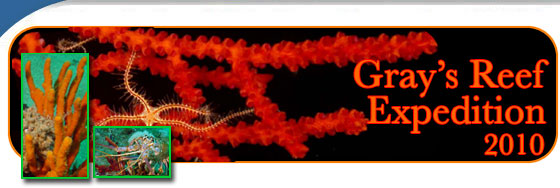Error processing SSI file
|
Mission Plan
The primary objective of this leg is to capture (using hook and line fishing gear) red snapper (Lutjanus campechanus), and two types of grouper: gag (Mycteroperca microlepis) and scamp (Mycteroperca phenax). Each fish will have an acoustic tag surgically implanted for tracking purposes.
The goal of this project is to learn more about the home range of these fish and what serves as preferred habitat for both the near and long term. Example questions of interest include: Do the fish go offshore to deeper shelf-edge reefs to spawn and then return to Gray’s Reef? Do they live at the same ledge the whole year? Is their residence time associated with their age and do they move out of the sanctuary as they grow larger?
Learning how these fish use the ledge habitat of the sanctuary will help us better manage the sanctuary for the benefit of all its resources including these reef-dwelling fish.
During a research cruise in 2008, scientists tagged eight fish (one gag, one red snapper, and six scamp) and deployed four acoustic receivers which detect the tagged fish. In 2009, scientists tagged another eight fish (four gag, two red snapper, one red grouper and one scamp) and deployed 10 more receivers.
Gray's Reef is currently considering making part of the sanctuary a "Research Area". This would be a no-take, no diving area, where scientists could observe how the ecosystem functions without fishing and disturbance by divers. The fish tagging project, in combination with other projects being considered for the research area, will give scientists an idea of how shallow reefs like Gray’s Reef serve as habitat for fish, how productive these reefs can be in the absence of disturbance, and how a natural balance of large predatory fish and their prey affect the reef and the community of invertebrates and fishes that live there. The acoustic tagging research will tell us how resident these large predatory fish are in the proposed closed area. The data will also give us insight into how closed areas might be helpful in restoring overfished species on local reefs.
Each tag placed inside a fish has a distinctive “ping” that identifies the individual fish. The tags emit a signal every two minutes that can be detected by the receivers within range (about 650 feet) of that signal. The implanted transmitters will last for up to three years before the battery is exhausted.
A colored plastic "spaghetti" tag is placed on the outside of the fish so scientists and anglers can easily tell an acoustically-tagged fish from an untagged fish.
Fish will be collected for tagging with the help of the Georgia Department of Natural Resources (GaDNR)using hook and line gear. Once captured, the fish will be measured, tagged externally with a spaghetti tag, and transported to the Nancy Foster. Aboard the Nancy Foster, an internal transmitter tag will be surgically implanted in the abdominal cavity of each fish. Fish are held and observed until healthy habits (swimming actively and upright) are resumed. Aquarists from the Georgia Marine Extension Service will ensure that the fish are handled carefully and returned to the sanctuary in good health. The fish will be released at the same site where they are captured.
In the months ahead, divers will recover the acoustic receivers from the buoy lines to which they are attached and bring the receivers to the surface. On the surface, crews clean and dry the receivers, then plug a Bluetooth © wireless adapter into the receiver. This allows the receiver to communicate with a laptop computer on board the boat. After the information is downloaded, divers return the receivers to the water where they can listen for more tagged fish. More information on this project can be found at here.
Several other projects are planned during the first leg of the Gray’s Reef Nancy Foster cruise. These include using the multi-beam system aboard the Nancy Foster to collect acoustic data for preparation of maps of habitats around the sanctuary. Multibeam operations will occur at night.
In addition, scientists will be collecting data on marine debris in the sanctuary. Nine sites were established in Gray’s Reef during 2007 and 2008 for the purpose of monitoring the accumulation of marine debris in the sanctuary. During leg one, divers will re-visit these nine locations to conduct annual monitoring of these survey sites.
Divers aboard the Nancy Foster will also be supporting research related to ocean chemistry. As part of NOAA's ocean acidification initiative, the University of Georgia and GRNMS have a seafloor observatory located at the sanctuary. This sensor platform records data in conjunction with a buoy monitoring CO2 in the air/sea interface. The CO2 and water quality sensors installed on the seafloor will be recovered during leg one, cleaned of fouling organic material and stored data will be downloaded. After servicing, the sensors will be redeployed on the seafloor observatory platform.
Finally, divers will be exploring several sites in the sanctuary to examine surficial geology. Approximately one mile from the Gray’s Reef buoy, a new site of interest, called the "Terraces," has been identified. The site has proven to have a very dynamic biological population as well as fossil bone fragments, fossil scallops and multiple level rock ledges. Fossilized scallops are commonly found in the sanctuary, but at the Terraces, the scallops have been observed stacked between the ledges instead of horizontally dispersed/cemented on the rock surface. Until recently, stacked scallops have only been identified at JY reef approximately 10 miles north of Gray’s Reef. Scientists will conduct several dives to further investigate this area.
|



